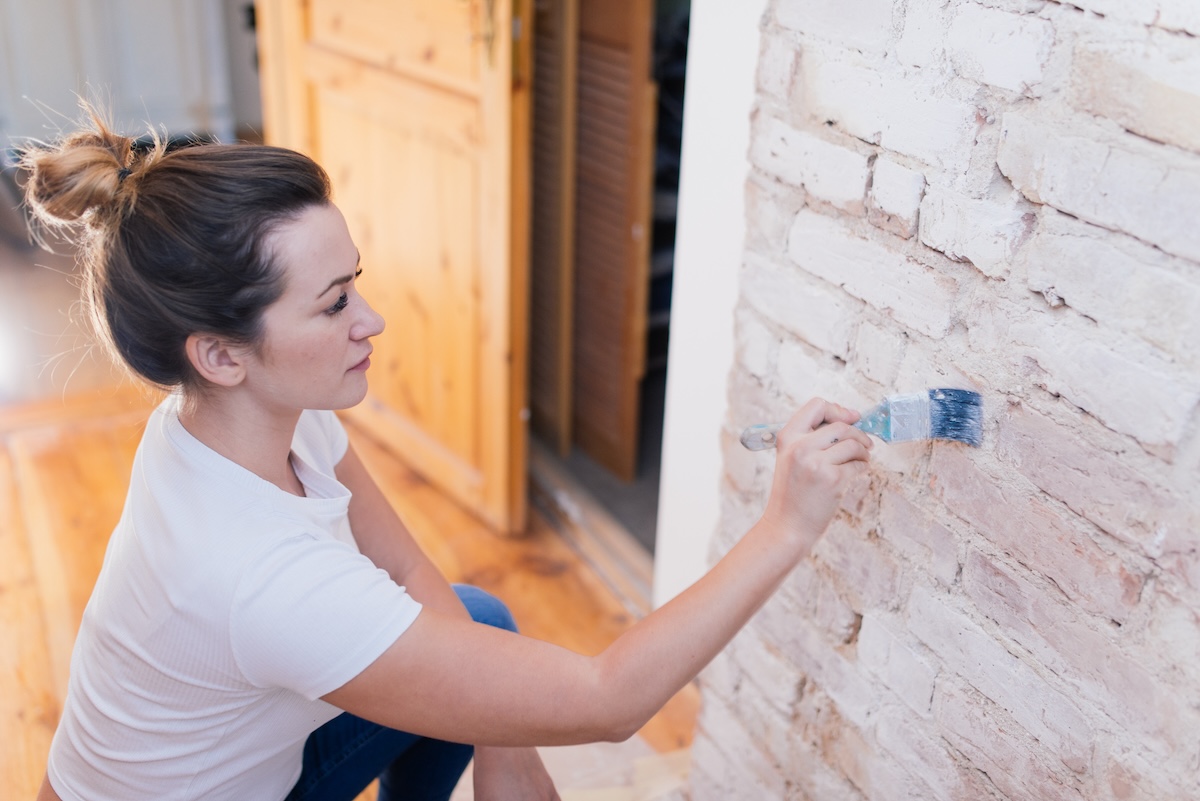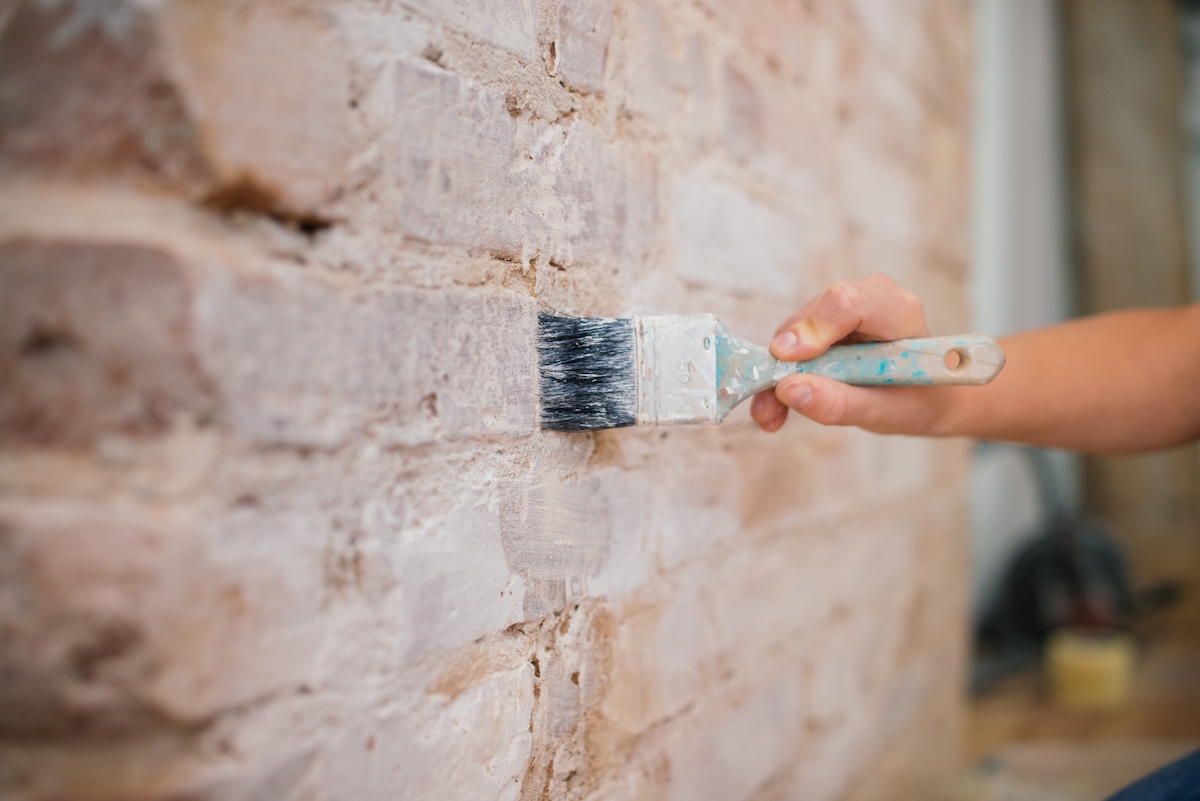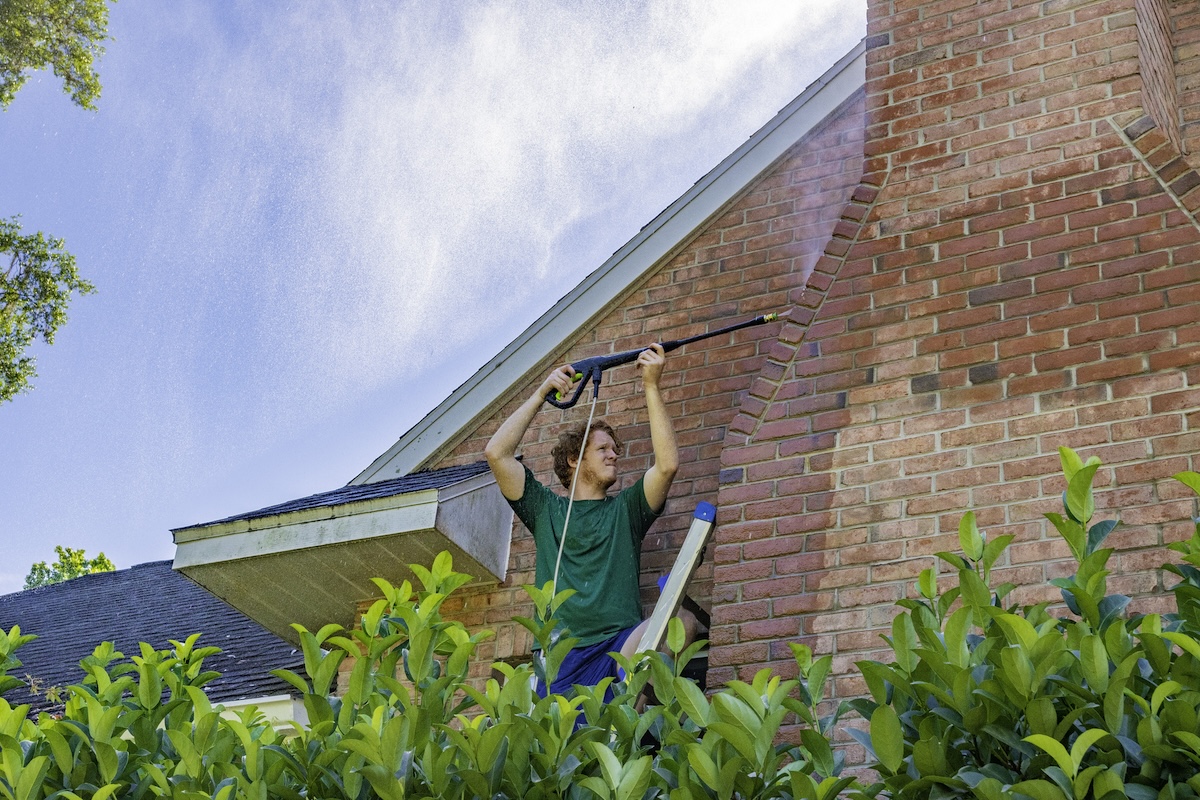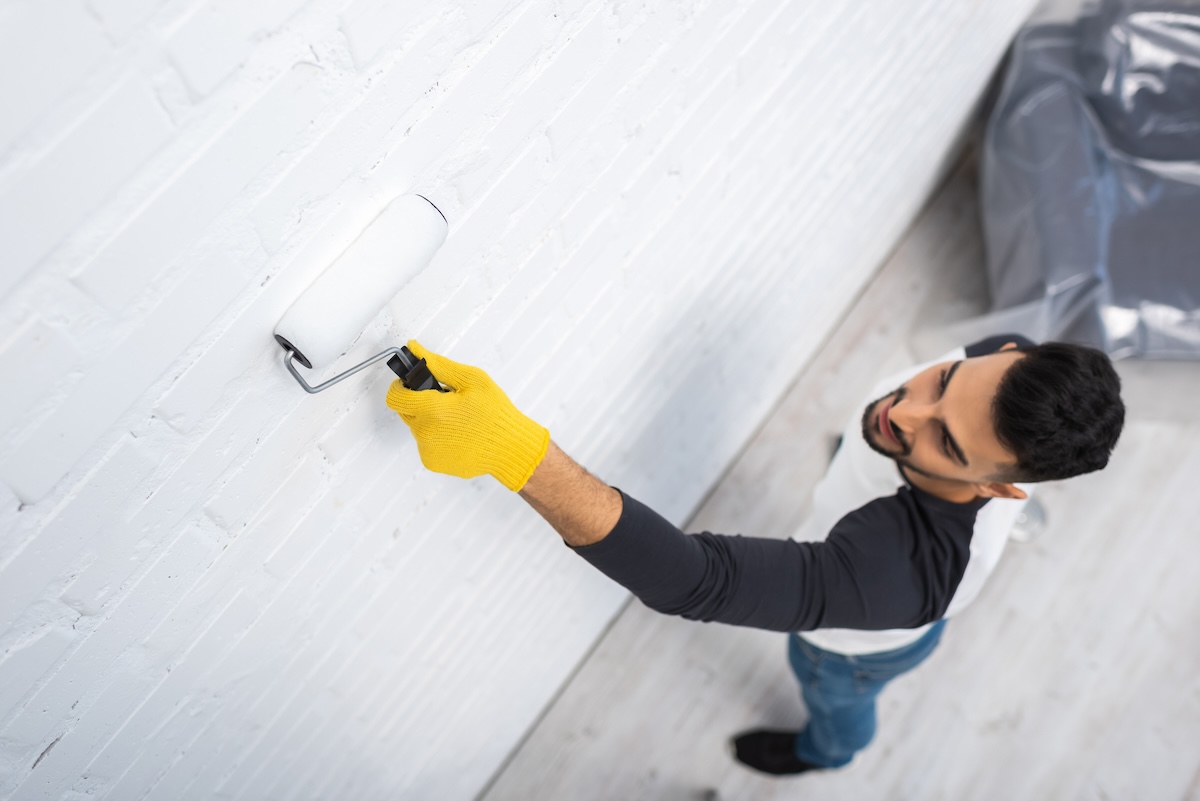

We may earn revenue from the products available on this page and participate in affiliate programs. Learn More ›
While a red brick exterior adds a classic and timeless look to a home, and red brick interior walls or fireplaces can bring a rustic look to a home’s interior, it’s not a look that appeals to everyone. Luckily, altering the look of brick is as simple as adding a fresh coat (or a few fresh coats), of paint over it.
There are both functional and aesthetic reasons for painting bricks. Adding a coat of paint over brick can modernize its traditional look while softening the heaviness that a brick wall can impart. Painting brick also can add an extra layer of protection by serving as a barrier that prevents moisture from soaking into the porous brick and potentially causing damage.
Although any DIYer can paint brick, following certain procedures and precautions ensures a successful finish. We tapped Anthony Kulikowski, owner of a Five Star Painting location in South Bend, Indiana, and a professional painter with 26 years of experience, for his advice on how to paint brick.

Tools & Materials
Bobvila.com may earn a commission from purchases made through these links.
Project Overview
Working Time: 5 to 16 hours
Total Time: 7 to 18 hours
Skill Level: Intermediate
Estimated Cost: $200 to $1,000
Before You Begin
Before you crack open a can of paint and go to work on your brick, first make sure it’s ready to receive the paint. If the brick has just been installed, you’ll need to give it about a year to dry out and acclimate before painting it. If you’re painting old brick, examine it for damage and make repairs to any crumbling brick or damaged mortar. Don’t attempt to paint over damaged areas. When ready to start painting, make sure the brick is completely dry or the paint could trap moisture inside.
It’s also helpful to gather together your painting tools. When painting indoors or around objects that need protection, tape off areas and lay down drop cloths as needed before applying primer or paint.
The best way to paint brick involves a 3-step process that includes surface prep, priming, and applying the paint using a paint sprayer.
How to Paint Brick, Indoors and Out
Step 1: Clean and prep the brick.

Before painting brick, always clean it thoroughly so that the applied paint adheres. Kulikowski recommends using a power washer if you’re painting a home’s exterior to get it truly clean. Painting interior brick walls requires less effort. “Most of the time, sweeping them off and dusting them off really well is enough,” he says. “If it’s a fireplace and there’s soot, you’ll need to get a little more aggressive and maybe use a trisodium phosphate (TSP) cleaner and a wire brush,” says Kulikowski. A half cup of TSP mixed into a gallon of water in a bucket ought to do the trick.
Where you encounter mildew, apply a solution of one part bleach to three parts water. After letting it soak for 30 minutes, proceed to scrub the area with a wire brush. Never use acid cleaning solutions, any of which might compromise the paint job. After cleaning, give the brick about 24 hours to fully dry. “It should be dry before you paint, otherwise you’ll trap water in there and probably get some bubbles,” Kulikowski says.

Tried-and-True Advice
“Like any surface getting a new coat a paint, brick and its associated mortar joints should be clean and reasonably dust-free. On a mainly interior application, I hit the mortar joints with a stiff bristle brush. This’ll dislodge a bunch of dust, which I’ll then sweep off with a whisk broom. I let it all fall to the floor or drop cloth then sweep or vac before painting. I don’t want to leave it there during the paint process because I’ll end up walking in it and dragging it through the house.
On an exterior application, it’s hard to beat a pressure washer for prep. I like a rotating 1,500-psi rotating spray time or a 25-degree tip for this.
I like moving blankets for drop cloths because they’re stiff-ish and lay flatter than flimsy fabric or, worse, single-use plastic. And, I can use them for other things throughout the year.”
—Mark Clement, Contributing Writer
Step 2: Apply primer.
The first step to painting brick is to start with a good primer. “The one we use is Sherwin-Williams Loxon masonry primer,” Kulikowski says. “It sticks really well to the brick, and it gives the brick a little breathing room.”
A sprayer is the preferred method for applying primer if you’re coating an exterior. For interiors, Kulikowksi says he uses a roller and brush. “I recommend a thicker nap roller,” he says. “I like a ¾-inch nap for brick because it will help you work the paint into the mortar joints. Plus, you won’t have to dip as much because the roller holds a bit more.”
Coat the brick using the roller, then fill in the gaps with a brush. Put additional coats on those sections that have been affected either by efflorescence or mildew. Whether you add one coat of primer or a few, let the primer dry completely, about 3 hours, before going any further.
Step 3: Pick your paint.
Many favor the use of elastodynamic paint for brick. It features (as the term implies) a high level of elasticity, which makes it excellent for filling cracks as well as preventing them. Plus, elastodynamic paint performs well in all weather, not only in precipitation but also in high humidity. We recommend Behr Premium elastomeric masonry, stucco, and brick exterior paint. When determining how to paint a brick fireplace, opt for the best brick fireplace paint for the job.
If you cannot find or don’t wish to use elastodynamic paint, don’t hesitate to opt instead for an acrylic paint. Kulikowski recommends Sherwin-Williams paints—Latitude for exterior and Pro Classic for interior. Just be prepared to use more paint than you would for a regular wall. “The brick will soak it up quite a bit,” Kulikowski says. “An average gallon of paint on drywall gets 350 to 400 square feet. With brick, you’re probably getting 150 to 200 square feet” of coverage. He recommends going with a semi-gloss finish, especially for fireplaces, since it’s easier to clean than flatter finishes.
Step 4: Apply the first coast of paint.
As with primer, when painting exterior brick surfaces, a paint sprayer will speed up the work. Weekend DIYers’ favorites are available from manufacturers such as Wagner, Tacklife, and HomeRight. For interior walls or fireplaces, brushes or rollers are sufficient. Use the same process to apply the paint as you did to apply the primer, using a thick nap roller and brush.
Step 5: Apply a second coat.

After you’re done painting the first coat, let it dry for the time recommended on the paint can, generally 3 to 4 hours. Even though it might feel dry to the touch after 3 hours or less, it is safer to wait at least 4 hours before applying a second coat. Be sure to check inside mortar joints between bricks to add paint with a brush as necessary on the final coat. Once the final coat is dry, remove the painter’s tape.
FAQs
Painting brick involves coating the entire brick wall, including mortar, using an acrylic or latex-based paint. Brick staining involves applying a finish to the brick that consists of mineral-based pigments that soak into the porous material, staining it. Kulikowski says the advantage of a stain is that it won’t peel or flake. “They’re just a bit chalky,” he says. “When it’s time to recoat, you can do a simple power wash and recoat.” Paint, on the other hand, will peel as it ages and hence requires extensive scraping before repainting. The downside to a stain is that it isn’t washable like paint is, meaning any stains from dirt are permanent.
The average cost to hire a professional painter to paint the exterior of a brick house is $1.40 to $4.20 per square foot, according to HomeAdvisor. If you’re painting the brick yourself, expect to spend about 12 cents to 28 cents per square foot, not including the cost of brushes, rollers, a sprayer, or other supplies.
